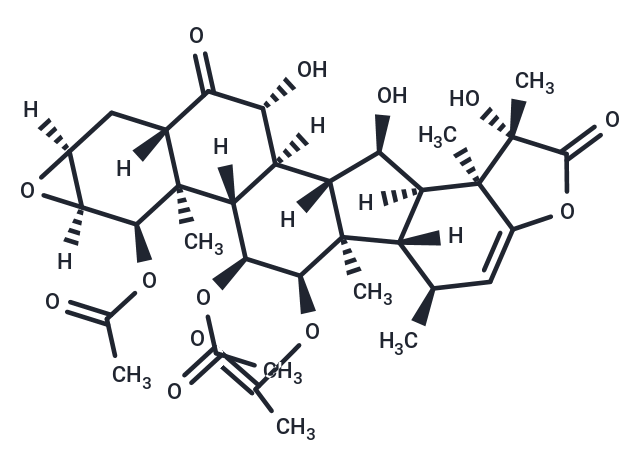Shopping Cart
- Remove All
 Your shopping cart is currently empty
Your shopping cart is currently empty

Taccalonolide B is effective in vitro against cell lines that overexpress P-glycoprotein (Pgp) and multidrug-resistance protein (MRP7). Taccalonolide B inhibits growth of SK-OV-3 cells with an IC50 of 208 nM.

| Pack Size | Price | Availability | Quantity |
|---|---|---|---|
| 1 mg | $48 | In Stock | |
| 5 mg | $118 | In Stock | |
| 10 mg | $198 | In Stock | |
| 25 mg | Inquiry | In Stock | |
| 50 mg | Inquiry | In Stock |
| Description | Taccalonolide B is effective in vitro against cell lines that overexpress P-glycoprotein (Pgp) and multidrug-resistance protein (MRP7). Taccalonolide B inhibits growth of SK-OV-3 cells with an IC50 of 208 nM. |
| In vitro | The structures were elucidated using a combination of spectroscopic methods, including 1D and 2D NMR and HR-ESI-MS. Taccalonolide AJ, an epoxidation product of Taccalonolide B, was generated by semisynthesis. Five of these taccalonolides demonstrated cellular microtubule-stabilizing activities and antiproliferative actions against cancer cells, with taccalonolide AJ exhibiting the highest potency with an IC50 value of 4.2 nM. The range of potencies of these compounds, from 4.2 nM to >50 μM, for the first time provides the opportunity to identify specific structural moieties crucial for potent biological activities as well as those that impede optimal cellular effects. In mechanistic assays, taccalonolides AF and AJ stimulated the polymerization of purified tubulin, an activity that had not previously been observed for taccalonolides A and B, providing the first evidence that this class of microtubule stabilizers can interact directly with tubulin/microtubules. Taccalonolides AF and AJ were able to enhance tubulin polymerization to the same extent as paclitaxel but exhibited a distinct kinetic profile, suggesting a distinct binding mode or the possibility of a new binding site. |
| Molecular Weight | 660.71 |
| Formula | C34H44O13 |
| Cas No. | 108885-69-4 |
| Smiles | C[C@@]12[C@@]3([C@]([C@]4([C@](C)([C@@H](OC(C)=O)[C@H]3OC(C)=O)[C@@]5([C@@]([C@@H]4O)([C@]6(C)C(=C[C@H]5C)OC(=O)[C@@]6(C)O)[H])[H])[H])([C@@H](O)C(=O)[C@]1(C[C@]7([C@@]([C@@H]2OC(C)=O)(O7)[H])[H])[H])[H])[H] |
| Relative Density. | 1.43 g/cm3 at 20℃ |
| Storage | store at low temperature | Powder: -20°C for 3 years | In solvent: -80°C for 1 year | Shipping with blue ice. |

Copyright © 2015-2024 TargetMol Chemicals Inc. All Rights Reserved.